What Is A Fleur De Lis Abdominoplasty?
A fleur de lis abdominoplasty is an operation designed to rejuvenate the abdominal area and removes excess fat and skin. It is often performed for patients who have a lot of skin/fat excess in the upper abdomen and the flanks. It can also be used where patients already have midline abdominal scars to help rejuvenate.
Who Is The Surgery Suitable For?
For those of normal stable body weight who have developed excess skin and / or fat where a standard tummy tuck may not address the upper abdomen and flank areas.
Who Is It Not Suitable For?
Those who have been encouraged to improve their contour by others. Those with unrealistic expectations, those who smoke and those with a significant medical history. Those who plan to have more children should consider the pros and cons of an operation.
What Is The Cost Of Fleur De Lis Abdominoplasty Surgery?
There is no set cost for a fleur de lis abdominoplasty operation as it greatly depends on what is required for each patient. After a consultation, if you are suitable for a fleur de lis abdominoplasty, you will be given a quote for the hospital, surgeon and anaesthetic fees.
What To Expect During Your Consultation?
The success of the consultation depends on your openness and honesty in relation to what troubles you and your expectations of surgery. You will be asked questions about your health, desires and lifestyle. Different operations can be tailored to your needs and the potential outcomes and the risks and complications will be discussed with you. The operation removes excess tissue from the upper and lower abdominal area and needs to be tailored to the individual. It also helps to narrow the waist and addresses the excess tissue in the flanks. A fleur de lis abdominoplasty can be tailored to each individual and can be combined with liposuction and other rejuvenation procedures such as breast rejuvenation. It involves abdominal skin removal and tightening of the abdominal muscles. A consultation regarding the risks and limitations of surgery will help you to choose a procedure that will meet your expectations.
Preparing For Fleur De Lis Abdominoplasty Surgery
This is a procedure that is performed under general anaesthetic. Your health is of prime importance and any cosmetic surgery should be postponed if you are unwell for any reason. It is important that if anything changes with your health that you make contact with us. You should ideally stop smoking 6 weeks prior to surgery and stop taking aspirin, anti-inflammatory drugs and herbal supplements before surgery. You may need preoperative tests prior to surgery, which we will arrange if required.
You will generally experience abdominal discomfort following the surgery and should aim to be off work for at least 2 weeks depending on the type of work you do. Often it can take 4 weeks to recover from a fleur de lis abdominoplasty and occasionally there can be healing issues at the join of the vertical and horizontal scar.
The Surgery
A fleur de lis abdominoplasty takes between 2-3 hours. Usually an incision is made just above the pubic region. The longer the scar the more tissue can be removed and you will need to discuss the length of your scar at a consultation. A vertical line is drawn down the middle of the abdomen and skin is excised on either side of this in a triangle. The skin is separated from the underlying tissue from the pubic region upwards. The extent of dissection will vary from patient to patient. The abdominal wall is tightened and the tummy button relocated. Excess fat and skin is removed. The incisions are closed with dissolvable stitches and the skin is repositioned. It is unusual to require drains and a compressive dressing is almost always required. You can browse our case studies to see the before and after, as well as the healing progression from Gary Ross’s surgeries.
After Surgery
You will usually return to the ward within an hour following surgery and you will be encouraged to mobilise. You will not have a catheter in place and it is unusual to require drains. You will be able to eat / drink and and mobilise as soon as the anaesthetic wears off. You will feel swollen and have abdominal discomfort that will usually require analgesia. You will be able to go home the next day and should keep the incision areas dry for the next week. You should arrange for someone to pick you up following surgery and have some support at home on discharge. You will be reviewed in the clinic and the wounds will be checked. You should avoid excessive straining in the first week and should continue to wear a support garment for 4-6 weeks after surgery. You will be able to resume light exercises after a week and normal exercise by 3-4 weeks. You should begin massage to the scar once healed. The healing from a fleur de lis can be longer than a standard tummy tuck and frequently the point that has the most problems is the join of the vertical and horizontal scar.
The images below are a women’s preops, 1 week images and can be compared to 4 weeks where there is a healing issue at the join. This does heal but can take a few weeks. Her longer term scar is shown for comparison.
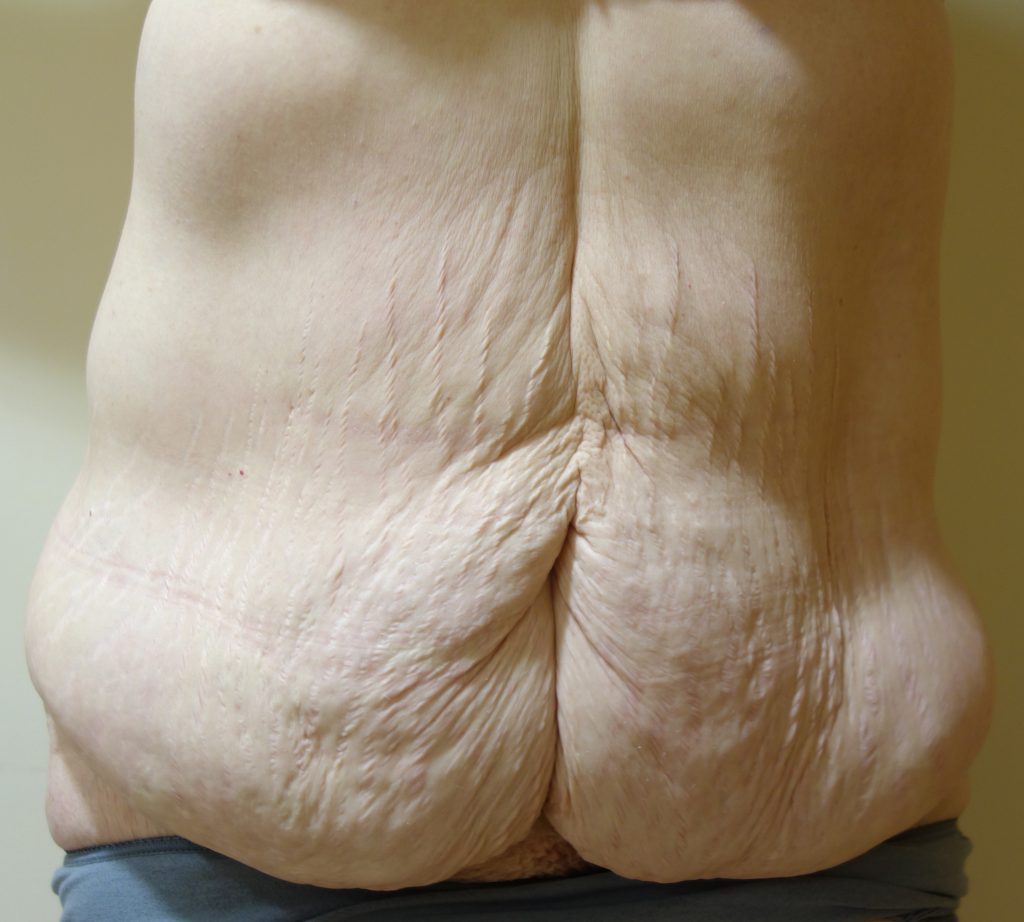
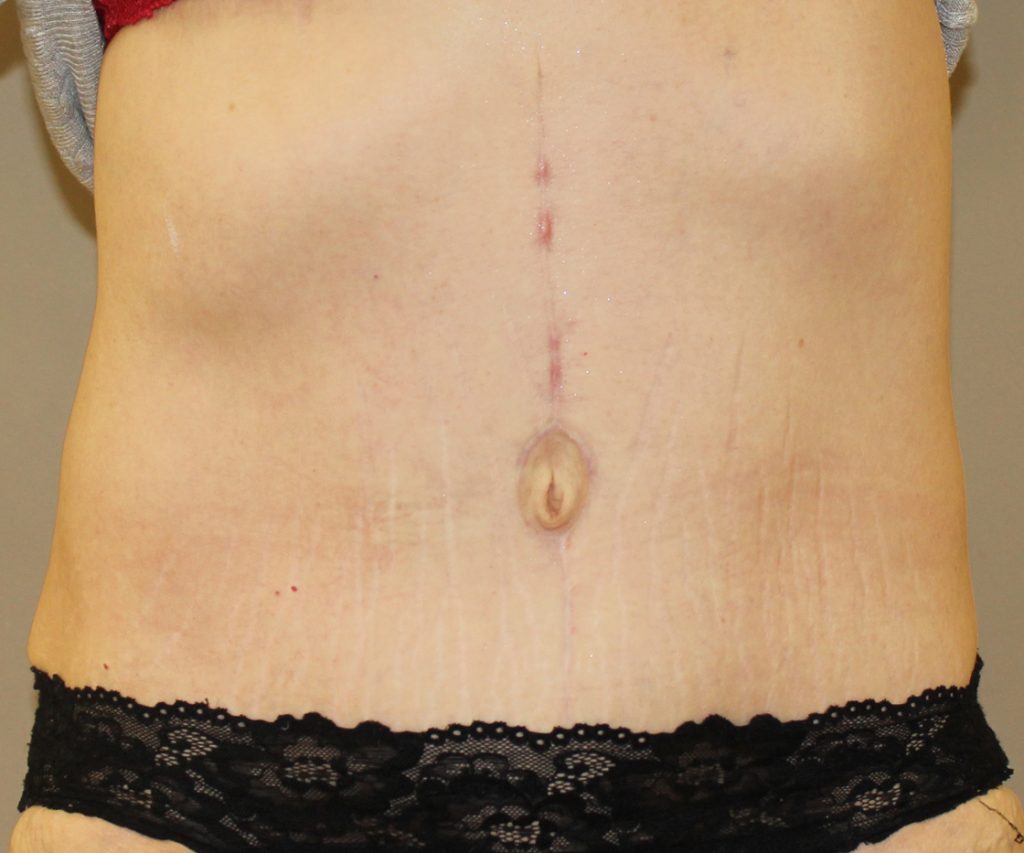
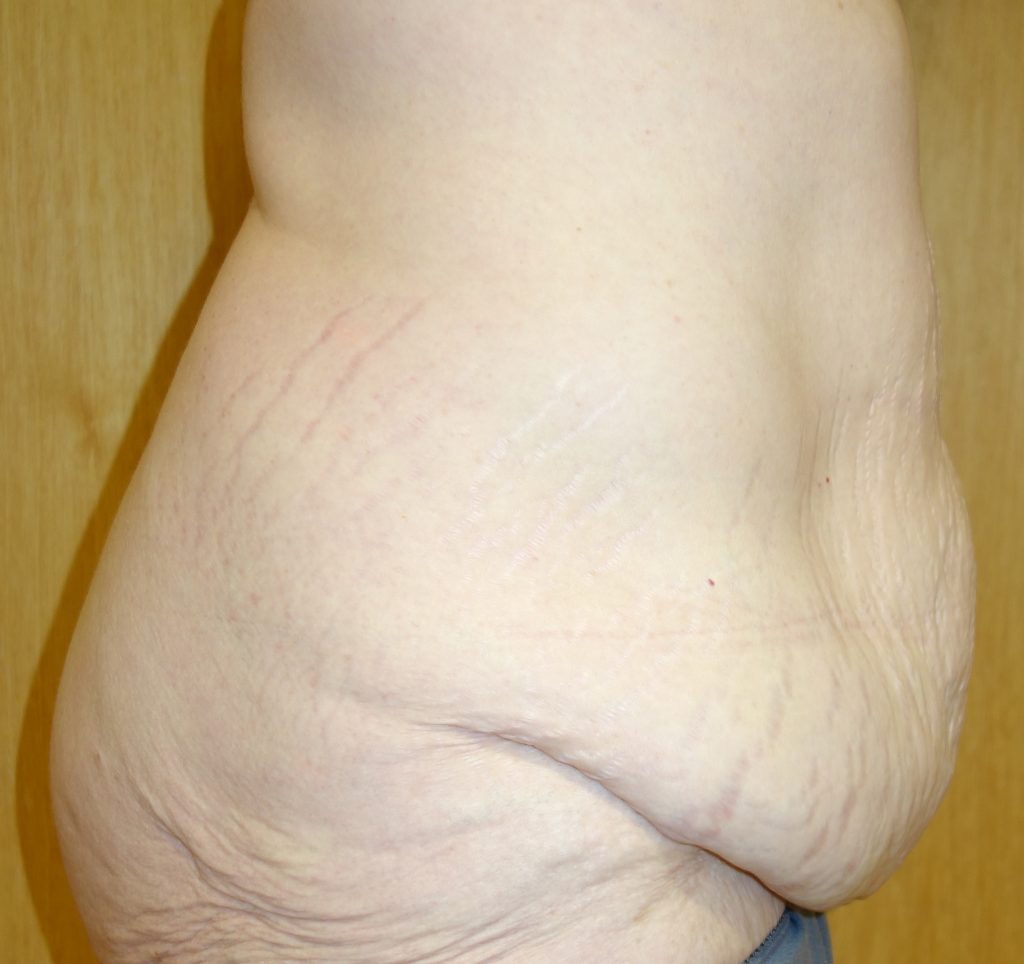
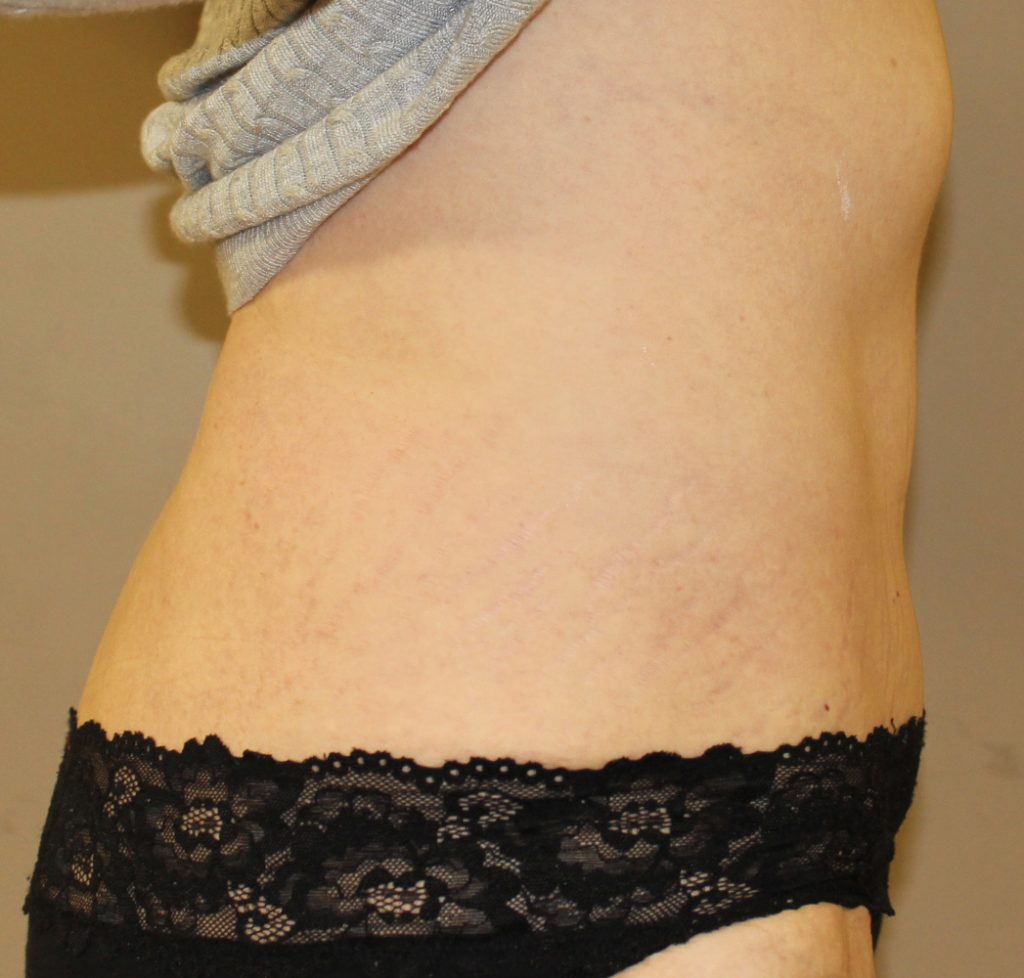

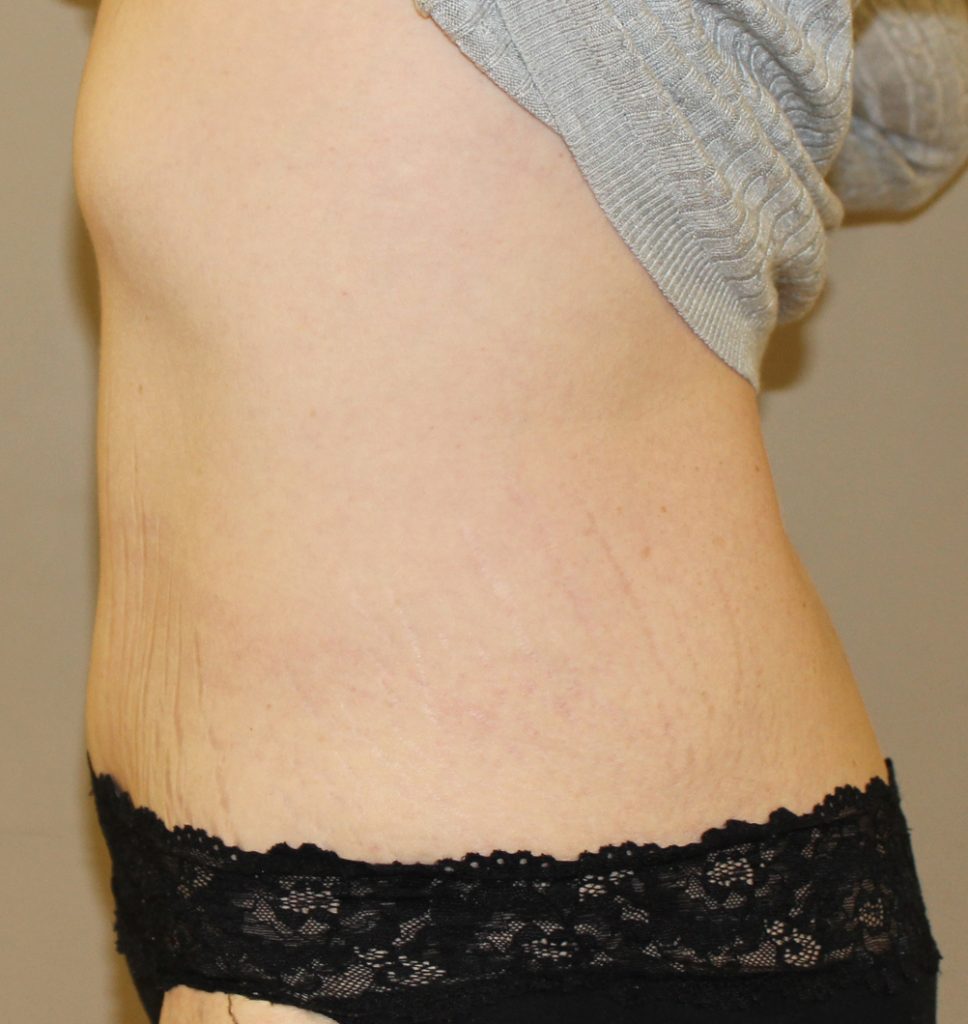
Risks And Complications
The vast majority of patients are delighted with the procedure although common complaints include numbness, bruising, swelling especially around the scar line and often there is a slight difference between the two sides of the abdomen. Uncommon complications include infection, haematoma, delayed healing/skin necrosis/skin loss, seroma formation and thickened scar. There are uncommon risks of general anaesthesia such as respiratory / cardiac compromise and deep vein thrombosis.
Sensation usually changes following a fleur de lis abdominoplasty. Although permanent numbness is uncommon, sensation can take a number of months to return. The scars following a mini tummy tuck can be red for a number of weeks / months after surgery and it can take some time before the scars start turning purple / pink and then start fading into a white line. It is unusual to develop abnormal scars and unusual to have irregularities requiring scar revision. Any revisions to the scars should not be considered for at least a year following surgery. The scar is often not symmetrical and the scar can move slightly with time. The abdomen can become lax with time and the result can fluctuate with fluctuations in weight.
The Cost of a Fleur De Lis Tummy Tuck in the UK
Prices can vary when it comes to fleur de lis abdominoplasty, and will differ based on your personal circumstances, health history, and what you want to get out of the surgery. Fleur de lis tummy tucks tend to cost more than regular tummy tucks, because they are a more invasive and time consuming procedure. During your initial consultation with Mr Ross, he will provide you with a full breakdown of your costs, including the surgery, hospital fees, and anaesthesia costs. Contact us today to book a consultation and find out a price breakdown for fleur de lis abdominoplasty.
Choosing between a regular tummy tuck and a fleur de lis tummy tuck can be difficult, but there are a few crucial differences that could help you decide which procedure you want. The fleur de lis abdominoplasty is good if someone has a high volume of both vertical and horizontal skin sagginess, as it is more invasive. However, if you have only horizontal skin laxity, a regular tummy tuck may be the best option for you. A responsible and accomplished surgeon like Mr Ross will not perform a fleur de lis tummy tuck if you only require a regular abdominal tuck. If you are struggling to decide which type of tummy tuck you would like, book a fleur de lis tummy tuck consultation with Mr Ross today.
Both the fleur de lis abdominoplasty and the tummy tuck are very effective and can provide amazing results depending on the amount and type of skin laxity a person has. The fleur de lis tummy tuck can treat a large amount of skin laxity, particularly if it hangs vertically. Many people prefer the fleur de lis tummy tuck if they need a more drastic aesthetic change, however, which procedure is best for you is best decided by an accomplished and experienced surgeon. If you’re debating whether to get a fleur de lis abdominoplasty or regular tummy tuck, seek the advice of an established surgeon such as Mr Ross and the team .
There are many positives of a fleur de lis tummy tuck when compared to a regular tummy tuck. For example, the fleur de lis abdominoplasty is able to remove large amounts of excess skin, particularly if the skin handbags vertically. A tummy tuck is limited in how much skin laxity it can treat, and it is usually best for when the skin hangs horizontally. The fleur de lis tummy tuck is capable of creating a more dramatic aesthetic change, so if you’re looking for a huge transformation, you may want to consider a fleur de lis abdominoplasty procedure. If you’re considering an invasive procedure such as a fleur de lis tummy tuck, you should consider looking at testimonials to see if it would be right for your needs. However, there are some things to consider if you want to get a fleur de lis tummy tuck. The procedure results in more extensive scars due to the invasive nature of the surgery, and the surgery time is also a bit longer than a regular tummy tuck. The price of a fleur de lis abdominoplasty is also significantly more than a regular tummy tuck, so you will need to take this into consideration during your consultation.
























